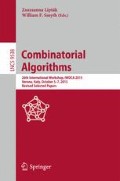Abstract
The zero forcing number of a graph is a graph parameter based on a color change process, which starts with a state, where all vertices are colored either black or white. In the next step a white vertex turns black, if it is the only white neighbor of some black vertex, and this step is then iterated. The zero forcing number Z(G) is defined as the minimum cardinality of a set S of black vertices such that the whole vertex set turns black.
In this paper we study Z(G) for the class of bijection graphs, where a bijection graph is a graph on 2n vertices that can be partitioned into two parts with n vertices each, joined by a perfect matching. For this class of graphs we show an upper bound for the zero forcing number and classify the graphs that attain this bound. We improve the general lower bound for the zero forcing number, which is \(Z(G)\ge \delta (G)\), for certain bijection graphs and use this improved bound to find the exact value of the zero forcing number for these graphs. This extends and strengthens results of Yi (2012) about the more restricted class of so called permutation graphs.
Access this chapter
Tax calculation will be finalised at checkout
Purchases are for personal use only
Notes
- 1.
Note that the term permutation graph is also used in a different way in literature, see [12].
References
Amos, D., Caro, Y., Davila, R., Pepper, R.: Upper bounds on the \(k\)-forcing number of a graph. Discrete Appl. Math. 181, 1–10 (2015)
Barioli, F., et al.: (AIM minimum rank special graphs work group): zero forcing sets and the minimum rank of graphs. Linear Algebra Appl. 428(7), 1628–1648 (2008)
Barioli, F., et al.: Zero forcing parameters and minimum rank problems. Linear Algebra Appl. 433(2), 401–411 (2010)
Berman, A., et al.: An upper bound for the minimum rank of a graph. Linear Algebra Appl. 429(7), 1629–1638 (2008)
Burgarth, D., Giovannetti, V.: Full control by locally induced relaxation. Phys. Rev. Lett. 99, 100–501 (2007)
Burgarth, D., Maruyama, K.: Indirect hamiltonian identification through a small gateway. New J. Phys. 11, 103019 (2009)
Chilakamarri, K.B., Dean, N., Kang, C.X., Yi, E.: Iteration index of a zero forcing set in a graph. Bull. Inst. Combin. Appl. 64, 57–72 (2012)
Harary, F., Chartrand, C.: Planar permutation graphs. Annales de l’I.H.P. (B) Probabilités et Statistiques 3(4), 433–438 (1967)
Haynes, T.W., Hedetniemi, S.M., Hedetniemi, S.T., Henning, M.A.: Domination in graphs applied to electric power networks. SIAM J. Discrete Math. 15(4), 519–529 (2002)
Row, D.D.: A technique for computing the zero forcing number of a graph with a cut-vertex. Linear Algebra Appl. 436(12), 4423–4432 (2012)
Severini, S.: Nondiscriminatory propagation on trees. J. Phys. A: Math. Theor. 41, 482001 (2008)
Skiena, S.: Implementing Discrete Mathematics: Combinatorics and Graph Theory with Mathematica. Addison-Wesley, Reading, MA (1990)
Trefois, M., Delvenne, J.-C.: Zero forcing sets, constrained matchings and strong structural controllability. Linear Algebra Appl 484, 199–218 (2015). arXiv:1405.6222v1
Yi, E.: On zero forcing number of permutation graphs. In: Lin, G. (ed.) COCOA 2012. LNCS, vol. 7402, pp. 61–72. Springer, Heidelberg (2012)
Zhao, M., Kang, L., Chang, G.J.: Power domination in graphs. Discrete Math. 306(15), 1812–1816 (2006)
Author information
Authors and Affiliations
Corresponding author
Editor information
Editors and Affiliations
Rights and permissions
Copyright information
© 2016 Springer International Publishing Switzerland
About this paper
Cite this paper
Shcherbak, D., Jäger, G., Öhman, LD. (2016). On the Zero Forcing Number of Bijection Graphs. In: Lipták, Z., Smyth, W. (eds) Combinatorial Algorithms. IWOCA 2015. Lecture Notes in Computer Science(), vol 9538. Springer, Cham. https://doi.org/10.1007/978-3-319-29516-9_28
Download citation
DOI: https://doi.org/10.1007/978-3-319-29516-9_28
Published:
Publisher Name: Springer, Cham
Print ISBN: 978-3-319-29515-2
Online ISBN: 978-3-319-29516-9
eBook Packages: Computer ScienceComputer Science (R0)

